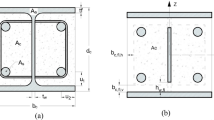Abstract
Missing fire protection material on steel structural members is generally recognized as a problem, though little information is available to quantify the effect. A finite element heat transfer analysis is used to compare the thermal response of steel columns with lost protection material when exposed to the ASTM E-119 furnace environment. Based on the predicted thermal response and using thermal endpoint criteria specified in ASTM E-119, estimates are made of the fire resistance of each column with varying amounts of missing protection. Relatively small proportional losses of fire protection material are required before significant reductions in fire resistance are realized. The degradation in fire resistance is most significant for light-weight columns and for cases where the fire protection material is missing from the flange rather than web.
Similar content being viewed by others
References
Malhotra, H.L.,Design of Fire-Resistive Structures, Chapman and Hall, New York (1982), p. 163.
Powers, W.,Report of Fire at One New York Plaza, New York, NY, August 5, 1970, The New York Board of Fire Underwriters, Bureau of Fire Prevention and Public Relations (1970).
Rains, W.A., “A New Era in Fire Protective Coatings for Steel,”Civil Engineering, ASCE (1976).
Willard, R.L.,The Effect of Incomplete Fireproofing on the Strength of Steel Beams, Department of Fire Protection of Engineering, University of Maryland, College Park, MD (1988).
American Society for Testing and Materials, ASTM E-119 88,Standard Methods of Fire Tests of Building Construction and Materials, ASTM, Philadelphia (1991).
Iding, R.H., Nizamuddin, Z., and Bresler, B.,FIRES-T3 A Computer Program for the FIreREspones ofStructures —ThermalThree Dimensional Version, Fire Research Group Report UCB 77-15, University of California, Berkeley (1977).
Milke, J.A., “Analytical Methods for Determining Fire Resistance of Steel Members,”Handbook of Fire Protection Engineering, P.J. DiNenno, Ed., NFPA, Quincy, MA (1988).
Shearman, R.J., Department of Fire Protection Engineering, University of Maryland, Private Communication (January 1992).
Milke, J.A., “Estimating the Fire Resistance of Tubular Steel Columns,”Proceedings of the Symposium on Hollow Structural Sections in Building Construction, ASCE, Chicago, IL (September 18, 1985).
Lie, T.T., and Stanzak, W.W., “Fire Resistance of Protected Steel Columns,”Engineering Journal/American Institute of Steel Construction, Vol. 10 (1973).
Underwriters Laboratories,Fire Resistance Directory, UL, Northbrook, IL (1992).
Author information
Authors and Affiliations
Rights and permissions
About this article
Cite this article
Tomecek, D.V., Milke, J.A. A study of the effect of partial loss of protection on the fire resistance of steel columns. Fire Technol 29, 3–21 (1993). https://doi.org/10.1007/BF01215355
Issue Date:
DOI: https://doi.org/10.1007/BF01215355



